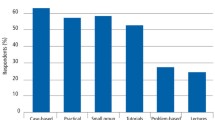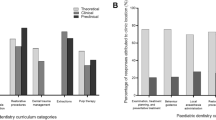Abstract
Purpose
To evaluate perceptions of fifth-year dental students’ towards case-based orthodontic education.
Methods
The sample population consisted of 108 final year dental students (39 men, 69 women) who volunteered to participate in the project during their orthodontic clinical internship. Patient files including extraoral, intraoral photographs, hand–wrist, panoramic and cephalometric radiographs were randomly distributed. Each group presented their evaluations after 1 week. At the end of case discussions, students were given a questionnaire regarding their perceptions of case-based education. Differences in mean scores between groups were compared by independent samples t‑test.
Results
The response rate was 100%. The majority of students strongly agreed that their interest and ability to interpret and diagnose the orthodontic data were increased. More than 60% strongly agreed that this education had a positive effect on their attention and effective learning. More than 45% strongly agreed that their communication with colleagues was increased, and women were significantly more inclined to group work than men (p < 0.05). More than 45% declared no additional burden.
Conclusions
Orthodontic case-based education was well received by final year dental students. The most noted improvement was observed in motivation, ability to comment on the diagnosis and treatment planning of orthodontic cases, without feeling an extra workload.
Zusammenfassung
Ziel
Untersucht wurde die Einstellung von Zahnmedizinstudierenden im fünften Studienjahr zur fallbezogenen kieferorthopädischen Ausbildung.
Methoden
Die Stichprobenpopulation bestand aus 108 Zahnmedizinstudierenden im letzten Studienjahr (39 Männer, 69 Frauen), die während ihres kieferorthopädischen klinischen Praktikums freiwillig an dem Projekt teilnahmen. Die Patientenakten mit extra- und intraoralen Fotos, Hand-Handgelenk‑, Panorama- und Fernröntgenaufnahmen wurden nach dem Zufallsprinzip verteilt. Jede Gruppe präsentierte ihre Auswertungen nach einer Woche. Nach Abschluss der Fallbesprechungen erhielten die Studenten einen Fragebogen zu ihren Wahrnehmungen der fallbezogenen Ausbildung. Die Unterschiede in den Mittelwerten zwischen den Gruppen wurden mit dem t‑Test für unabhängige Stichproben verglichen.
Ergebnisse
Die Rücklaufquote betrug 100 %. Die Mehrheit der Studierenden stimmte der Aussage, dass ihr Interesse und ihre Fähigkeit, die kieferorthopädischen Daten zu interpretieren und zu diagnostizieren, erhöht worden seien, entschieden zu. Mehr als 60% stimmten deutlich zu, dass diese Ausbildung einen positiven Effekt auf Aufmerksamkeit und effektives Lernen gehabt habe. Mehr als 45% stimmten stark zu, dass ihre Kommunikation mit Kollegen gesteigert worden sei, wobei Frauen signifikant häufiger zur Gruppenarbeit neigten als Männer (p < 0,05). Mehr als 45 % gaben keine zusätzliche Belastung an.
Schlussfolgerungen
Die fallbezogene kieferorthopädische Ausbildung wurde von den Zahnmedizinstudierenden im letzten Jahr des Studiums gut angenommen. Die am meisten wahrgenommene Verbesserung wurde beobachtet bei der Motivation und der Fähigkeit, die Diagnose und Behandlungsplanung von kieferorthopädischen Fällen zu kommentieren, ohne dass eine zusätzliche Arbeitsbelastung empfunden wurde.

Similar content being viewed by others
References
Garvey MT, O’Sullivan M, Blake M (2000) Multidisciplinary case-based learning for undergraduate students. Eur J Dent Educ 4(4):165–168. https://doi.org/10.1034/j.1600-0579.2000.040404.x
Chan WP, Hsu CY, Hong CY (2008) Innovative “case-based integrated teaching” in an undergraduate medical curriculum: development and teachers’ and students’ responses. Ann Acad Med Singapore 37(11):952–956
Oesterle LJ, Shellhart WC (1998) Assessing the use of CD-ROM technology in case-based learning. Eur J Dent Educ 2(4):160–164. https://doi.org/10.1111/j.1600-0579.1998.tb00053.x
Engel FE, Hendricson WD (1994) A case-based learning model in orthodontics. J Dent Educ 58(10):762–767. https://doi.org/10.1002/j.0022-0337.1994.58.10.tb02897.x
Mavragani M (2016) Case-based learning in orthodontic undergraduate education. A pilot study at fourth-year dental students in Bergen. Department of Clinical Dentistry University of Bergen. https://bora.uib.no/bora-xmlui/handle/1956/15652
McLean SF (2016) Case-based learning and its application in medical and health-care fields: a review of worldwide literature. J Med Educ Curric Dev 27:3. https://doi.org/10.4137/JMECD.S20377
Thistlethwaite JE, Davies D, Ekeocha S, Kidd JM, MacDougall C, Matthews P, Purkis J, Clay D (2012) The effectiveness of case-based learning in health professional education. A BEME systematic review: BEME Guide No. 23. Med Teach 34(6):e421–e444. https://doi.org/10.3109/0142159X.2012.680939
Nadershahi NA, Bender DJ, Beck L, Lyon C, Blaseio A (2013) An overview of case-based and problem-based learning methodologies for dental education. J Dent Educ 77(10):1300–1305. https://doi.org/10.1002/j.0022-0337.2013.77.10.tb05603.x
Haley CM, Brown B, Koerber A, Nicholas CL, Belcher A (2019) Comparing Case-Based with Team-Based Learning: Dental Students’ Satisfaction, Level of Learning, and Resources Needed. J Dent Educ 84(4):486–494. https://doi.org/10.21815/JDE.019.190
Ilgüy M, Ilgüy D, Fişekçioğlu E, Oktay I (2014) Comparison of case-based and lecture-based learning in dental education using the SOLO taxonomy. J Dent Educ 78(11):1521–1527. https://doi.org/10.1002/j.0022-0337.2014.78.11.tb05827.x
Yang Z, Ding Y, Jin Z, Jin F (2015) Student perceptions of effectiveness of case-based learning in orthodontic education. Open Med J 2:48–52. https://doi.org/10.2174/1874220301401010048
Tadlock LP, Barone N, Pangrazio-Kulbersh V, Sabott DG, Foley PF, Trulove TS, Park JH, Hernandez-Orsini R, Chung CH (2019) American Board of Orthodontics: Update on the new scenario-based clinical examination. Am J Orthod Dentofacial Orthop 155(6):765–766. https://doi.org/10.1016/j.ajodo.2019.04.004
Schwartz PL, Egan AG, Health CJ (1994) Students’ perceptions of course outcomes and learning styles in case-based courses in a traditional medical school. Acad Med 69(6):507. https://doi.org/10.1097/00001888-199406000-00021
Williams B (2009) Do undergraduate paramedic students embrace case-based learning using a blenched teaching approach? A 3‑year review. AJET. https://doi.org/10.14742/ajet.1143
Curran VR, Sharpe D, Forristall J, Flynn K (2008) Student satisfaction and perceptions of small group process in case-based interprofessional learning. Med Teach 30(4):431–433. https://doi.org/10.1080/01421590802047323
Peplow P (1998) Attitudes and examination performance of female and male medical students in active, case-based learning programme in anatomy. Med Teach 20(4):349–355. https://doi.org/10.1080/01421599880788
Author information
Authors and Affiliations
Corresponding author
Ethics declarations
Conflict of interest
B. Balos Tuncer, T. Sokmen, B. Celik and T. Tortop declare that they have no competing interests.
Ethical standards
The study protocol was approved by Gazi University Ethics Committee (91610558-604.01.02). Written informed consent to participate and written informed consent for publication were obtained from the patients’ parents.
Additional information
Publisher’s Note
Springer Nature remains neutral with regard to jurisdictional claims in published maps and institutional affiliations.
Availability of data and material
The datasets analyzed during the current study are available from the corresponding author on reasonable request.
Rights and permissions
About this article
Cite this article
Balos Tuncer, B., Sokmen, T., Celik, B. et al. Perception of dental students towards case-based orthodontic education. J Orofac Orthop 83 (Suppl 1), 96–101 (2022). https://doi.org/10.1007/s00056-021-00325-y
Received:
Accepted:
Published:
Issue Date:
DOI: https://doi.org/10.1007/s00056-021-00325-y




